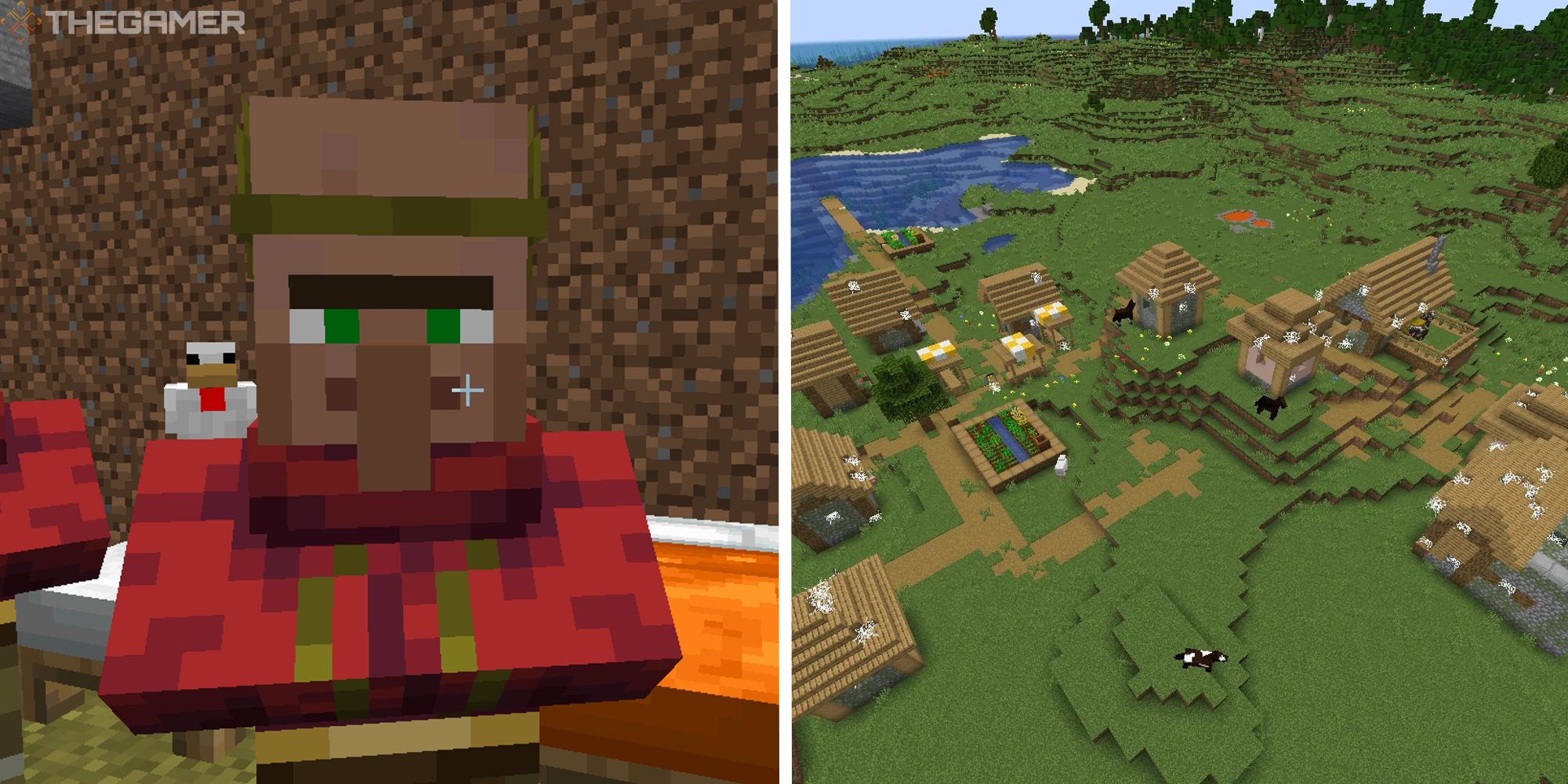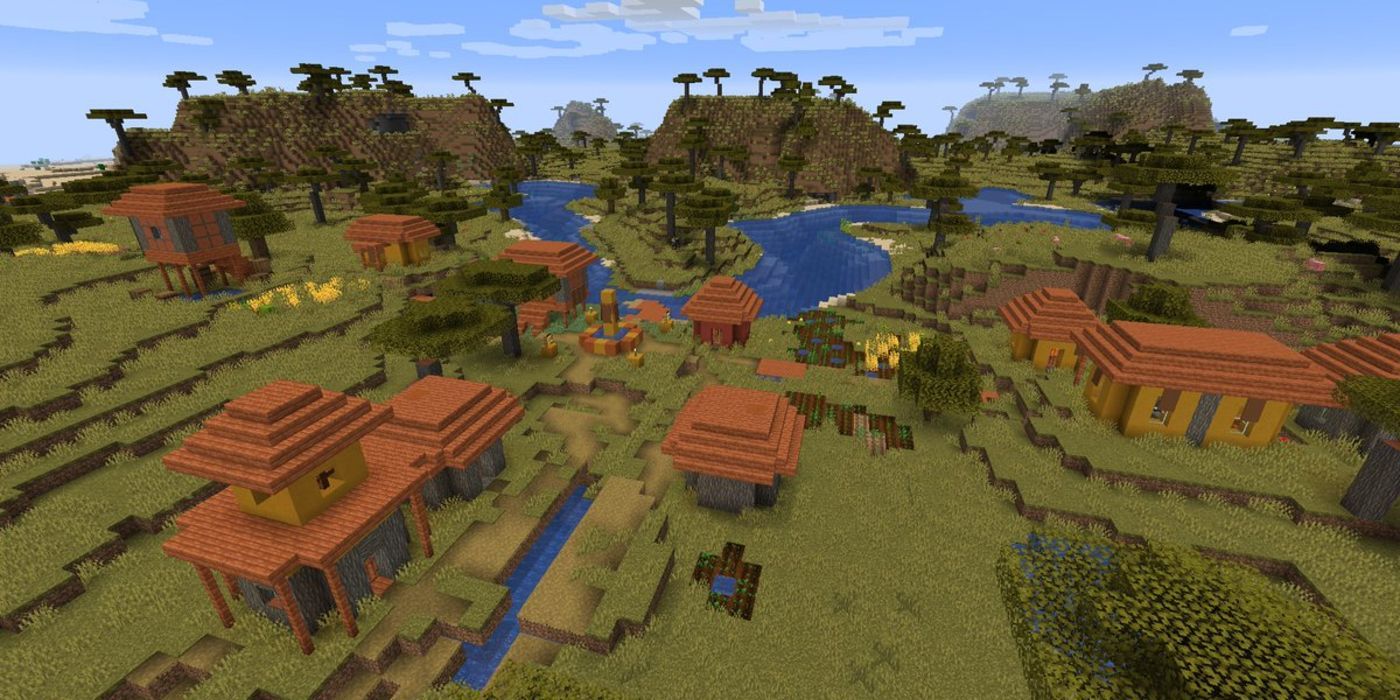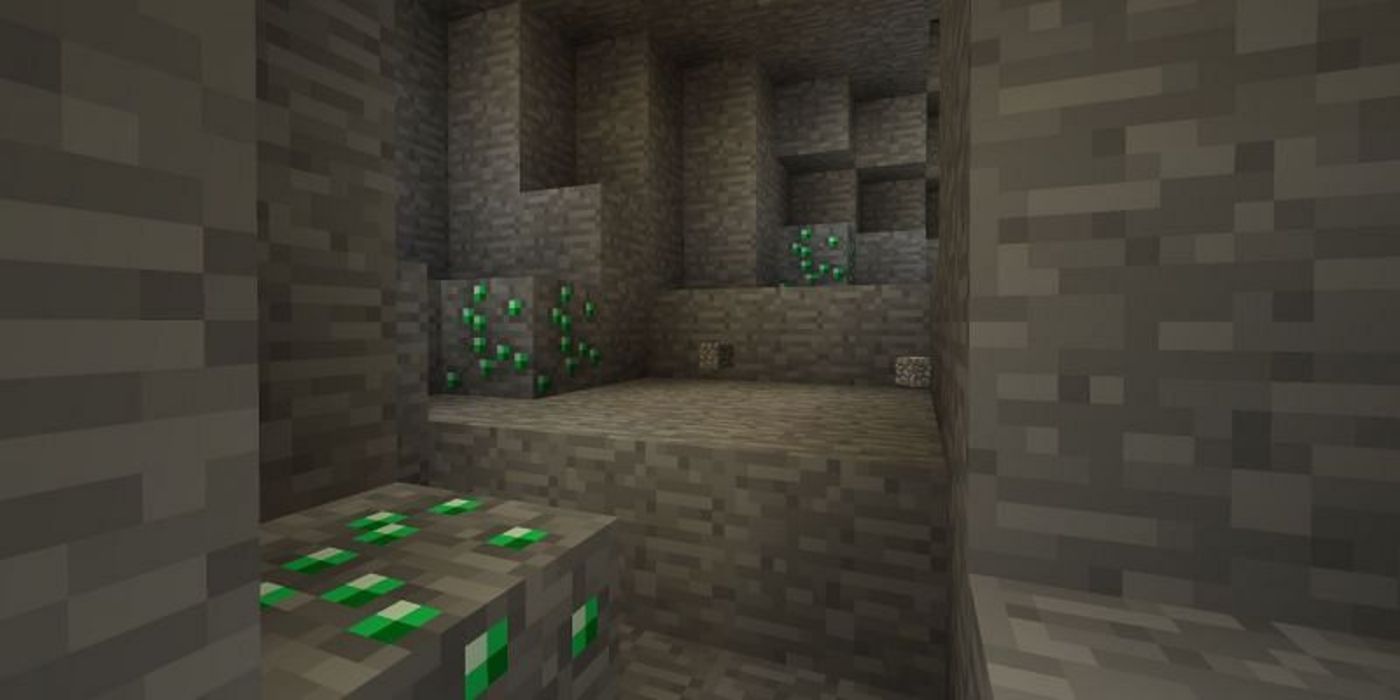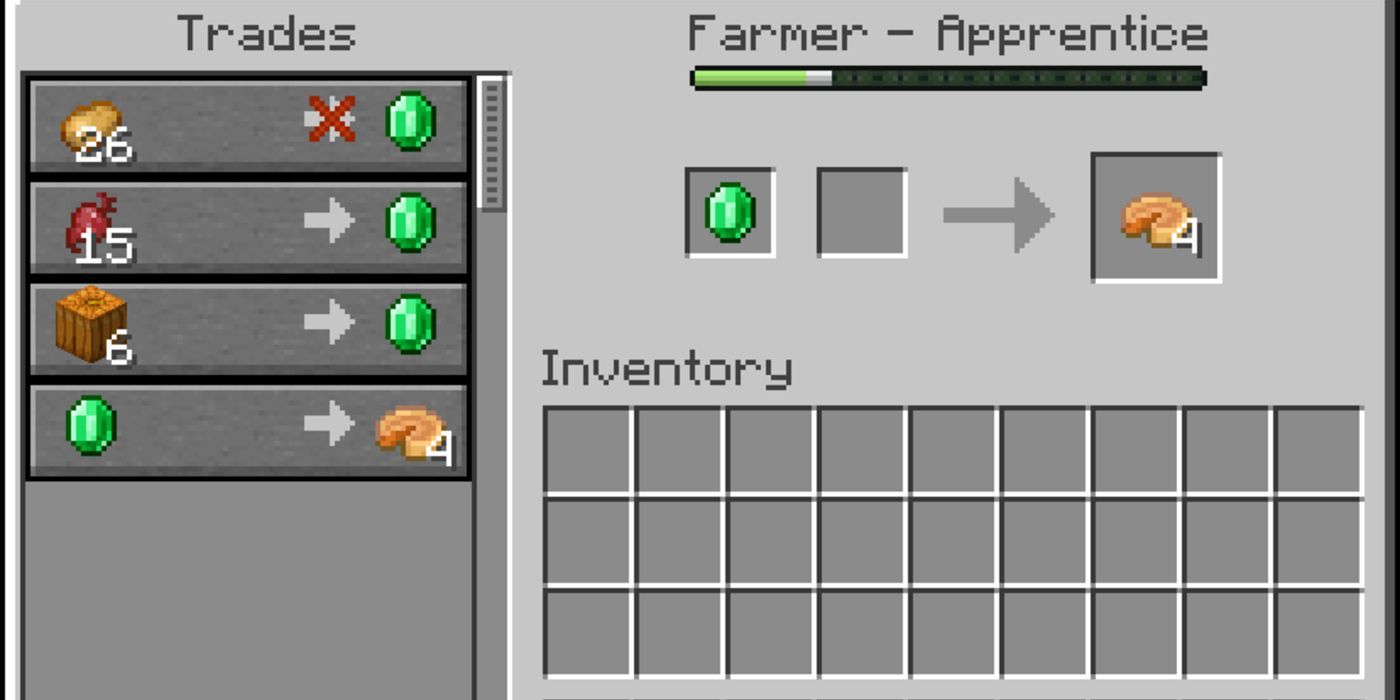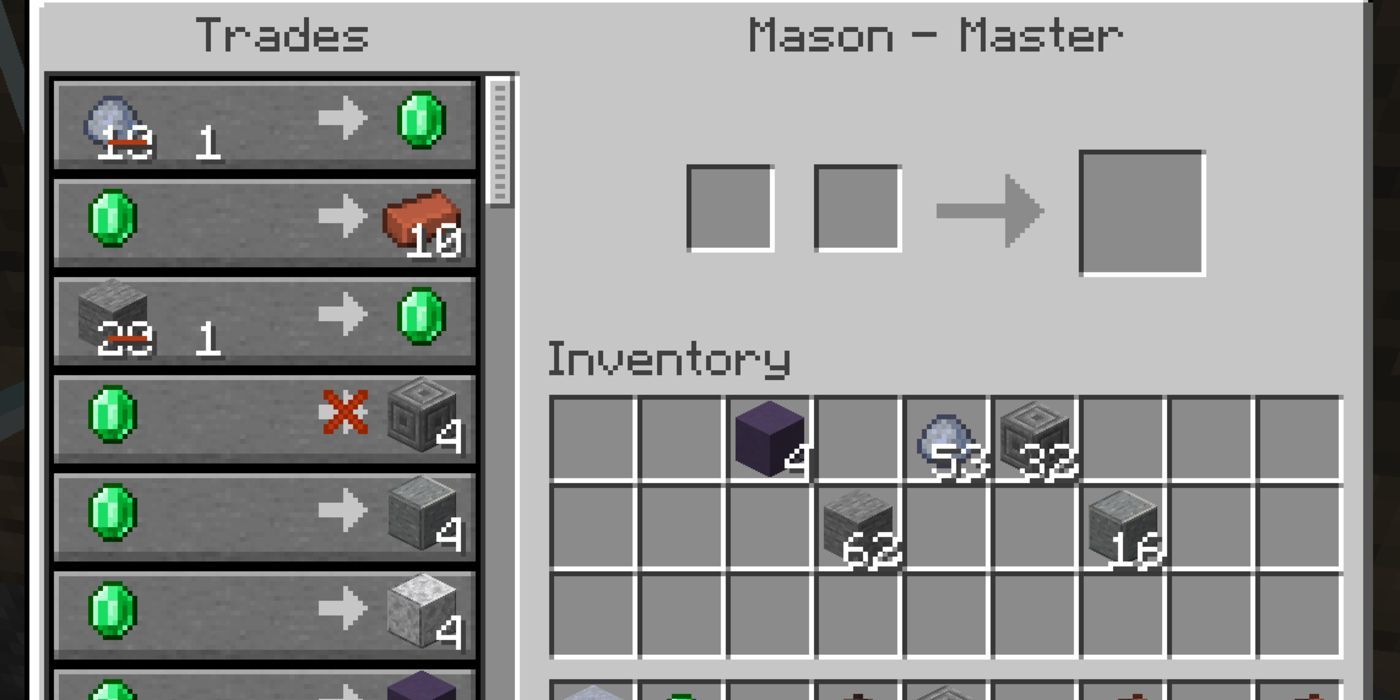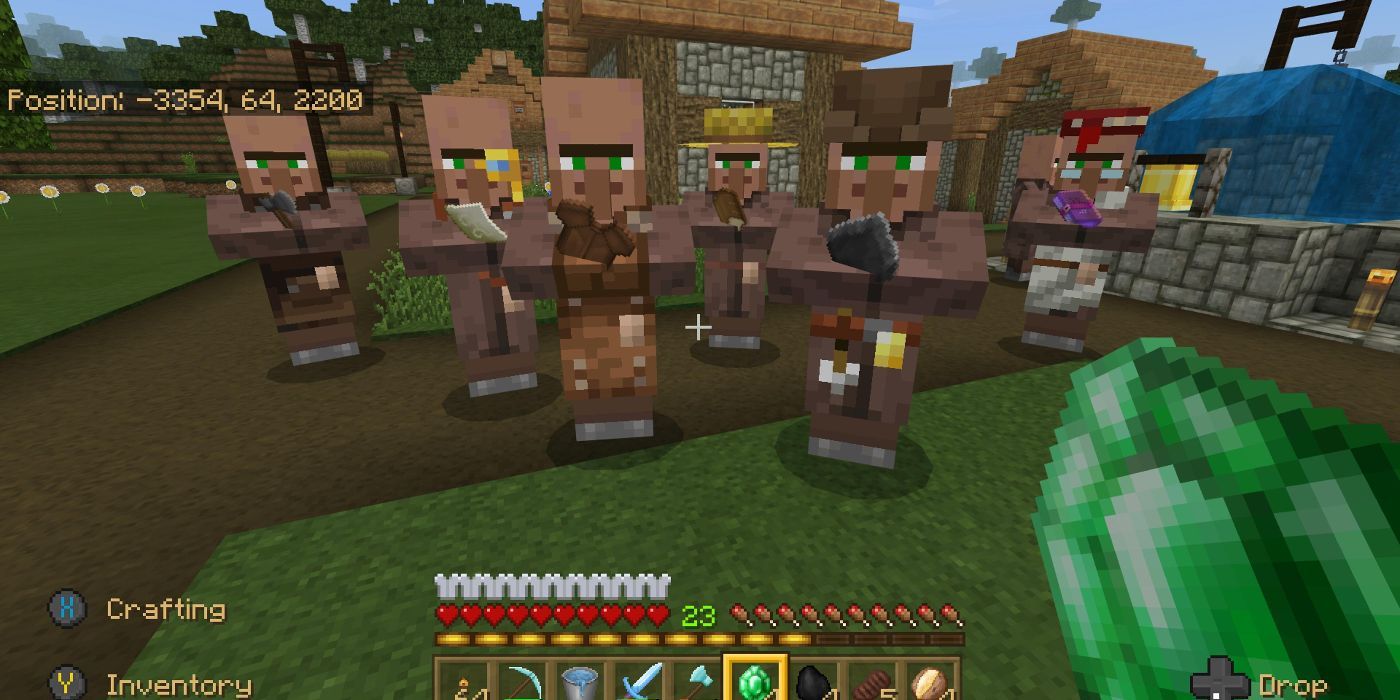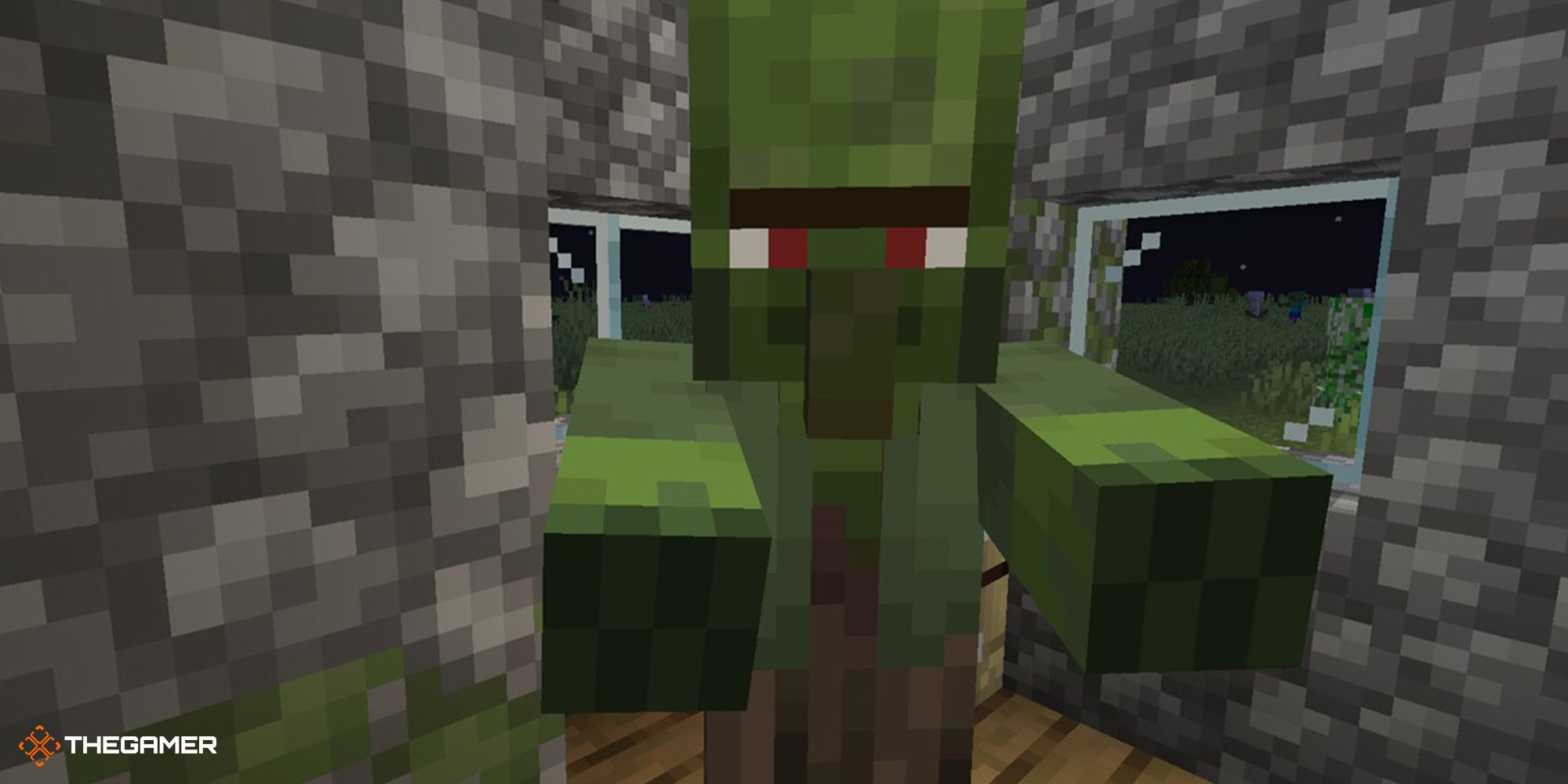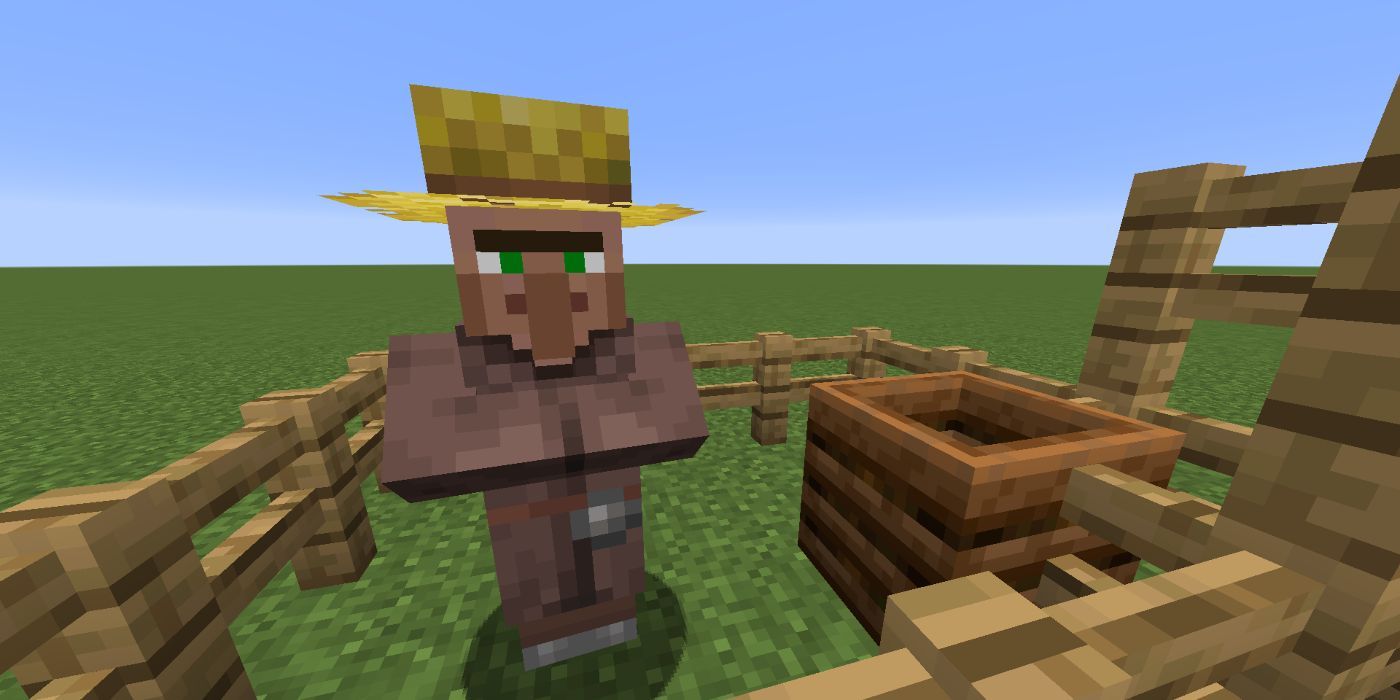Quick Links
A major feature in Minecraft is trading with villagers. The trading feature has since been extended to the Wandering Trader as well as Piglins in the Nether, to help diversify the game. However, the main method for trading still remains trading with villagers of different professions in a village.
Trading might seem complex at first, but it actually remains a very simple feature at its core. This guide will break down all trades for each profession, as well as explain how trading works in the first place.
Updated August 6, 2023 by Jacqueline Zalace: Creating a villager trading hall in Minecraft is one of the best ways to obtain a lot of resources. As such, we've updated this guide with even more information on how to trade with villagers.
Finding A Village
In order to trade, you'll need to find a village. Fortunately, villages are quite common. You can find a village in the following biomes. Additionally, each village will have a different style based on the biome.
- Plains
- Savanna
- Taiga
- Meadows
- Snowy Plains (Bedrock exclusive)
- Snowy Taiga (Bedrock exclusive)
- Desert
Overall, villages aren't that rare; by taking a short expedition around the area, you may find one. Villages don't spawn too close together, as well as too often in the same biome, so if you are near multiple biomes, be sure to search them all.
How To Find Emeralds
Now, it's time to get yourself some emeralds. Emeralds are the primary currency for trading with villagers. They're not easy to get your hands on, but there are a few ways of getting them, which you can check out below.
|
Location |
Notes |
|---|---|
|
Trading With Villagers |
To build up your emerald supply, you can trade basic items (sticks, bread, etc.) with villagers to make a few emeralds. |
|
Village Chests |
Emeralds have a small chance to spawn within chests in village houses. |
|
Mining |
Emeralds can be found while mining, with it being most common at Y level 256. |
|
Buried Treasure and Shipwrecks |
Chests in these locations have a small chance to hold emeralds, but it is not a good way to farm this currency. |
If you plan on mining for emeralds, it's important to note that this is incredibly high. Y=256 is unreachable from most biomes; you will instead need to find a mountain or peak biome that has large stone mountains reaching into the sky.
In a biome with high peaks, you should be able to find plenty of emeralds, with many possibly exposed on the surface.
Villager Trading And Leveling
To start trading, right-click on a villager with a uniform. Each profession has a unique costume that sets them apart from one another. You can also hold an item or emerald in your hand, and if a villager holds something in their hand in turn, it means they are willing to trade with you for that item.
Villagers will level up as you trade with them. Every villager begins at Novice level, followed by Apprentice, Journeyman, Expert, and Master. Each level unlocks more trade options you can take advantage of. A villager's level progress is marked at the top of the trading interface, and their level is marked by the orb at their uniform's belt.
Unemployed villagers and Nitwits cannot be traded with. You can place a job block near an unemployed villager to give it a job, but Nitwits (wearing green) will never be able to have a job.
If you're not happy with a specific trade, you can always mine out the villager's workstation and place it back down. This resets their trades and all level progress. With Librarians, this method is particularly useful, since Librarians have a chance of having any enchanted book as their first trade, including rare ones like Mending and Infinity.
Generally, you'll want to secure a few villagers with good emerald trades. These are trades, which are cheap to make and will get you some emeralds, so that you can afford more important trades with other villagers.
Villager Stock
Just like in real life, supply and demand are important aspects of trading with villagers. Every trade is limited by its supply, meaning you can't expect to endlessly trade with a villager when it comes to a specific item. The more valuable the trade, the less the villager will have in stock.
To combat this, you can have multiple villagers with the same job. This allows you to trade more items without having to wait until the following day.
In order for the stock to be reset, the villager needs to work at their workstation, which generally happens a maximum of twice a day. The trade will remain disabled until the villager has restocked again.
Pricing
When it comes to pricing, there are a number of things that affect it, which you should be vigilant about.
|
Effect |
Description |
|---|---|
|
Popularity |
High popularity from trading with many villagers will lower prices, while low popularity from harming a villager will result in higher prices. |
|
Sold Out Items |
Any trade that becomes out of stock will see a significant price increase when in stock again. |
|
Hero Of The Village |
Beating a raid on a village gives you this status effect, which lowers all prices. |
Zombie Villagers
As their name implies, zombie villagers are villagers that have turned into zombies. While they are a zombie, they can attack and deal some serious damage. Fortunately, you can transform them back into a villager through a few steps, listed below.
- Capture the zombie villager.
-
Inflict Weakness on the zombie villager.
- Splash Potion of Weakness
- Tipped Arrow with Weakness Potion
- Lingering Potion of Weakness
-
Feed the weakened zombie villager a Golden Apple.
- You just need to toss it to them.
- The zombie villager will begin to shake, indicating that it is about to be cured.
Once the villager is cured, they will offer trade discounts to you that are permanent. Infecting and curing villagers is a great way to reduce the cost of items. You can continue to infect and cure the same villager until prices go down to one emerald (or one item).
For more information on curing a zombie villager, be sure to check out this guide.
All Trades Per Profession
Now, let's take a look at each profession, as well as what they sell at each level.
The numbers associated with each trade are the default prices, unaffected by curing.
Farmer
|
Novice |
Apprentice |
Journeyman |
Expert |
Master |
|---|---|---|---|---|
|
Wheat (20) or Potato (26) or Carrot (22) or Beetroot (15) = Emerald (1) Emerald (1) = Bread (6) |
Pumpkin (6) = Emerald (1) Emerald (1) = Pumpkin Pie (4) or Apple (4) |
Melon (4) = Emerald (1) Emerald (3) = Cookies (18) |
Emerald (1) = Suspicious Stew (1) Emerald (1) = Cake (1) |
Emerald (3) = Golden Carrot (3) Emerald (4) = Glistering Melon (3) |
Butcher
|
Novice |
Apprentice |
Journeyman |
Expert |
Master |
|---|---|---|---|---|
|
Raw Chicken (14) = Emerald (1) Raw Rabbit (4) = Emerald (1) Raw Porkchop (7) = Emerald (1) Emerald (1) = Rabbit Stew (1) |
Coal (15) = Emerald (1) Emerald (1) = Cooked Chicken (8) Emerald (1) = Cooked Porkchop (5) |
Raw Beef (10) = Emerald (1) Raw Mutton (7) = Emerald (1) |
Dried Kelp Block (10) = Emerald (1) |
Sweet Berries (10) = Emerald (1) |
Fisherman
|
Novice |
Apprentice |
Journeyman |
Expert |
Master |
|---|---|---|---|---|
|
String (20) = Emerald (1) Coal (10) = Emerald (1) Emerald (1) = Bucket of Cod (1) Emerald (1) and Raw Cod (6) = Cooked Cod (6) |
Raw Cod (15) = Emerald (1) Emerald (1) = Campfire Emerald (1) and Raw Salmon (6) = Cooked Salmon (6) |
Raw Salmon (13) = Emerald (1) Emerald (7-22) = Enchanted Fishing Rod (1) |
Tropical Fish (6) = Emerald (1) |
Pufferfish (4) = Emerald (1) Boat (1) = Emerald (1) |
Shepherd
|
Novice |
Apprentice |
Journeyman |
Expert |
Master |
|---|---|---|---|---|
|
White/Brown/Black/Brown/Gray Wool (18) = Emerald (1) Emerald (2) = Shears (1) |
Black/White/Light Blue/Lime/Gray Dye (12) = Emerald (1) Emerald (1) = Colored Wool (1) Emerald (1) = Colored Carpet (4) |
Yellow/Red/Orange/Pink/Light Gray Dye (12) = Emerald (1) Emerald (3) = Colored Bed (1) |
Green/Magenta/Purple/Cyan/Blue/Brown/Green Dye (12) = Emerald (1) Emerald (3) = Colored Blank Banner (1) |
Emerald (2) = Painting (3) |
Mason
|
Novice |
Apprentice |
Journeyman |
Expert |
Master |
|---|---|---|---|---|
|
Clay Ball (10) = Emerald (1) Emerald (1) = Brick (10) |
Stone (20) = Emerald (1) Emerald (1) = Chiseled Stone Bricks (4) |
Granite/Andesite/Diorite (16) = Emerald (1) (E) Emerald (1) = Polished Granite/Andesite/Diorite (4) |
Nether Quartz (12) = Emerald (1) Emerald (1) = Colored or Glazed Terracotta (1) |
Emerald (1) = Block of Quartz or Quartz Pillar (1) |
Leatherworker
|
Novice |
Apprentice |
Journeyman |
Expert |
Master |
|---|---|---|---|---|
|
Leather (6) = Emerald (1) Emerald (3) = Leather Pants (1) Emerald (7) = Leather Tunic (1) |
Flint (26) = Emerald (1) Emerald (5) = Leather Cap (1) Emerald (4) = Leather Boots (1) |
Rabbit Hide (9) = Emerald (1) Emerald (7) = Leather Tunic (1) |
Scute (4) = Emerald (1) Emerald (6) = Leather Horse Armor |
Emerald (5) = Leather Cap Emerald (6) = Saddle |
Librarian
|
Novice |
Apprentice |
Journeyman |
Expert |
Master |
|---|---|---|---|---|
|
Paper (24) = Emerald (1) Emerald (5-64) and Book (1) = Enchanted Book Emerald (9) = Bookshelf (1) |
Book (4) = Emerald (1) Emerald (5-64) and Book (1) = Enchanted Book Emerald (1) = Lantern (1) |
Ink Sac (5) = Emerald (1) Emerald (5-64) and Book (1) = Enchanted Book Emerald (1) = Glass (4) |
Book and Quill (1) = Emerald (1) Emerald (5-64) and Book (1) = Enchanted Book Emerald (5) = Clock (1) Emerald (4) = Compass (1) |
Emerald (20) = Name Tag (1) |
Weaponsmith
|
Novice |
Apprentice |
Journeyman |
Expert |
Master |
|---|---|---|---|---|
|
Coal (15) = Emerald (1) Emerald (3) = Iron Axe (1) Emerald (7-21) = Enchanted Iron Sword (1) |
Iron Ingot (4) = Emerald (1) Emerald (36) = Bell (1) |
Flint (24) = Emerald (1) |
Diamond (1) = Emerald (1) Emerald (17-31) = Enchanted Diamond Axe (1) |
Emerald (13-27) = Enchanted Diamond Sword (1) |
Toolsmith
|
Novice |
Apprentice |
Journeyman |
Expert |
|
|---|---|---|---|---|
|
Coal (15) = Emerald (1) Emerald (1) = Stone Axe/Stone Shovel/Stone Pickaxe/Stone Hoe (1) |
Iron Ingot (4) = Emerald (1) Emerald (36) = Bell (1) |
Flint (30) = Emerald (1) Emerald (6-20) = Enchanted Iron Axe (1) Emerald (7-21) = Enchanted Iron Shovel (1) Emerald (8-22) = Enchanted Iron Pickaxe (1) Emerald (4) = Diamond Hoe (1) |
Diamond (1) = Emerald (1) Emerald (17-31) = Enchanted Diamond Axe (1) Emerald (10-24) = Enchanted Diamond Shovel (1) |
Emerald (18-32) = Enchanted Diamond Pickaxe (1) |
Fletcher
|
Novice |
Apprentice |
Journeyman |
Expert |
Master |
|---|---|---|---|---|
|
Stick (32) = Emerald (1) Emerald (1) = Arrow (16) Emerald (1) and Gravel (10) = Flint (10) |
Flint (26) = Emerald (1) Emerald (2) = Bow (1) |
String (14) = Emerald (1) Emerald (3) = Crossbow (1) |
Feather (24) = Emerald (1) Emerald (7-21) = Enchanted Bow (1) |
Emerald (2) and Arrow (5) = Tipped Arrow (5) Emerald (8-22) = Enchanted Crossbow (1) Tripwire Hook (8) = Emerald (1) |
Cleric
|
Novice |
Apprentice |
Journeyman |
Expert |
Master |
|---|---|---|---|---|
|
Rotten Flesh (32) = Emerald (1) Emerald (1) = Redstone Dust (2) |
Gold Ingot (3) = Emerald (1) Emerald (1) = Lapis Lazuli (1) |
Rabbit's Foot (2) = Emerald (1) Emerald (4) = Glowstone (1) |
Scute (4) = Emerald (1) Glass Bottle (9) = Emerald (1) Emerald (5) = Ender Pearl (1) |
Nether Wart (22) = Emerald (1) Emerald (1) = Bottle ol Enchanting (1) |
Armorer
|
Novice |
Apprentice |
Journeyman |
Expert |
Master |
|---|---|---|---|---|
|
Coal (15) = Emerald (1) Emerald (5) = Iron Helmet (1) Emerald (9) = Iron Chestplate (1) Emerald (7) = Iron Leggings (1) Emerald (4) = Iron Boots (1) |
Iron Ingot (4) = Emerald (1) Emerald (36) = Bell (1) Emerald (3) = Chainmail Leggings (1) Emerald (1) = Chainmail Boots (1) |
Lava Bucket (1) = Emerald (1) Diamond (1) = Emerald (1) Emerald (1) = Chainmail Helmet (1) Emerald (4) = Chainmail Chestplate (1) Emerald (5) = Shield (1) |
Emerald (19-33) = Enchanted Diamond Leggings (1) Emerald (13-27) = Enchanted Diamond Boots (1) |
Emerald (13-27) = Enchanted Diamond Helmet (1) Emerald (21-35) = Enchanted Diamond Chestplate |
Cartographer
|
Novice |
Apprentice |
Journeyman |
Expert |
Master |
|---|---|---|---|---|
|
Paper (24) = Emerald (1) Emerald (7) = Empty Map (1) |
Glass Pane (11) = Emerald (1) Emerald (13) and Compass (1) = Ocean Explorer Map (1) |
Compass (1) = Emerald (1) Emerald (14) and Compass (1) = Woodland Explorer Map (1) |
Emerald (7) = Item Frame (1) Emerald (3) = Colored Blank Banner (1) |
Emerald (8) = Globe Banner Pattern (1) |

